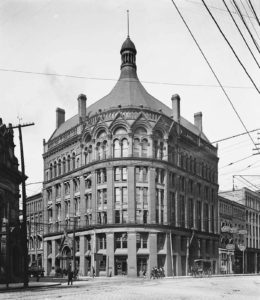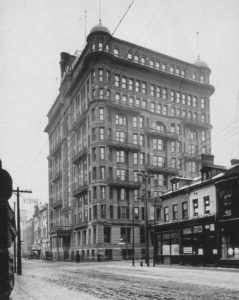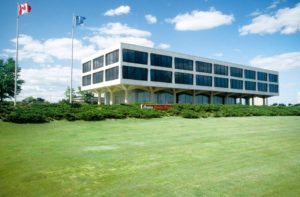Buildings lost to demolition in Toronto form a far too long list. Some dismantling of the old is required to pave way for the new, of course, but throughout the 1960s and 70s, this city unceremoniously destroyed some of its finest architecture, in some cases merely to building parking lots.
Here are my picks for the buildings most tragically lost to demolition in Toronto.
Trinity College (original)

Built: 1852
Demolished: 1950
What exists there now: Trinity Bellwoods Park, though the original gate and women’s residence still stand, the latter as a retirement home.
Why it’s missed: Designed by Kivas Tully, the building was an excellent example of Gothic-Revival architecture.
Old Union Station

Built: 1873
Demolished: 1931
What exists there now: Citigroup Place
Why it’s missed: As wonderful as the current Union Station is, think of what it’d be like to have the previous iteration of the station preserved and used for another purpose.
Toronto General Post Office

Built: 1873
Demolished: 1958
What exists there now: State Street Financial Centre
Why it’s missed: This was Toronto’s 8th post office and acted as the summit of the gorgeous Toronto St. Designed by Henry Langley, it was one of the city’s most ornate Second Empire buildings.
Grand Opera House

Built: 1874
Demolished: 1927
What exists there now: Scotia Plaza
Why it’s missed: A fabulous Second Empire-style building with an an intriguing history courtesy of one-time owner Ambrose Small, the millionaire that one day up and vanished, nothing like it remains in Toronto.
Board of Trade Building

Built: 1892
Demolished: 1958
What exists there now: EDS Building
Why it’s missed: Designed by New York’s James & James firm, the Board of Trade held a prominent place on the northeast corner of Yonge and Front streets. The rounded building was the perfect companion to the Flatiron a couple of streets away.
The Armouries

Built: 1894
Demolished: 1963
What exists there now: Provincial Court House (University Avenue)
Why it’s missed: Thomas Fuller’s Romanesque masterpiece was not only the largest armoury in Canada, but just look at what replaced it.
The Temple Building

Built: 1896
Demolished: 1970
What exists there now: Queen-Bay Centre
Why it’s missed: Aside from being the tallest building in Toronto upon its completion, George W. Gouinlock’s Tempe Building was a lovely Romanesque counterpart to nearby Old City Hall.
Chorley Park

Built: 1915 (started in 1911)
Demolished: 1961
What exists there now: Parkland
Why it’s missed: Chorley Park was the fourth and last official residence of the Lieutenant Governor of Upper Canada. Architect F.R. Heakes modelled it after the chateaux of the Loire Valley. The opulent building closed in 1937 due to the high maintenance costs. It served a few other uses before being razed.
The Toronto Star Building (original)

Built: 1929
Demolished: 1972
What exists there now: First Canadian Place
Why it’s missed: Designed by Chapman and Oxley, it was one of Toronto’s finest examples of Art Deco architecture.
Bata Building

Built: 1965
Demolished: 2007
What exists there now: Aga Kahn Museum grounds
Why it’s missed: While it’s been replaced by a worthy successor, the Bata Building was one of Toronto’s finest examples of modernist architecture. It might also have been John C. Parkin’s best architectural work, though that is up for debate.
